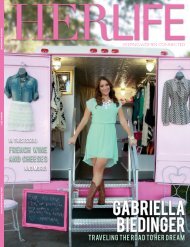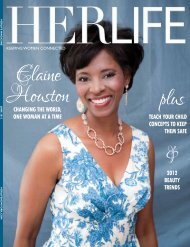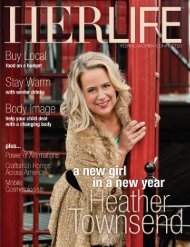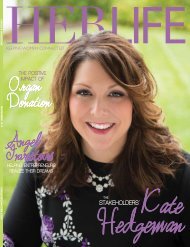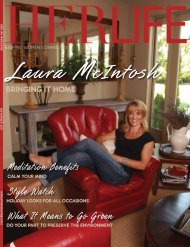keeping women connected - HERLIFE Magazine
keeping women connected - HERLIFE Magazine
keeping women connected - HERLIFE Magazine
You also want an ePaper? Increase the reach of your titles
YUMPU automatically turns print PDFs into web optimized ePapers that Google loves.
herlife | beauty<br />
Goin’ to the Chapel of Love,<br />
Potential Danger and<br />
Flying Bouquets:<br />
Why Wedding<br />
Dresses Are<br />
White and Other<br />
Wedding Traditions<br />
by chandra blackwell<br />
Whether your wedding bells are<br />
echoes from the distant past,<br />
still pealing in your newlywed<br />
ears, or softly chiming in your future, one<br />
thing’s for sure—you will always remember<br />
your wedding as the day you embarked upon a<br />
lifetime of love—togetherness and occasional<br />
befuddlement about why your beloved spouse<br />
does the things he or she does. But did you<br />
ever stop to wonder why we do the things we<br />
do at the wedding itself? How certain wedding<br />
traditions came about? Some of the answers<br />
may surprise you, but most of these traditions–<br />
just like love itself–have stood the test of time:<br />
All Dressed in White<br />
Prior to the mid-19th century, a bride’s<br />
attire was simply the best clothing she owned,<br />
in any color. Whereas today, the “layered<br />
look” isn’t something we normally associate<br />
with a wedding, a bride in those days often<br />
piled on layers of fur, silk and velvet, in order<br />
to convince her husband-to-be that she came<br />
from a well-to-do family. Then in 1840, Eng-<br />
land’s Queen Victoria stepped out in a white<br />
gown trimmed with orange blossoms for her<br />
wedding to Prince Albert, thereby becoming<br />
well-known not only for representing an era of<br />
emphasis on morals, modesty and decorum,<br />
but also for influencing the fashion choices of<br />
brides for centuries to come. From that point<br />
on, ivory-clad brides abounded, and white<br />
became the color of choice for weddings (and,<br />
ultimately, P. Diddy parties) the world over.<br />
Something Old,<br />
Something New<br />
Queen Victoria’s influence on weddings<br />
didn’t stop at the dress, however; the Victorian<br />
era also spawned the famous (and poetic)<br />
tradition whereby a bride wears certain items<br />
which, combined, are said to bring good luck.<br />
The “something old” forever links the bride<br />
to her past and to her family (even oddball<br />
Cousin Eddie, who took to wearing smoking<br />
jackets in fifth grade), while the “something<br />
new” represents a new life with a new family<br />
(weirdos included, but hopefully only<br />
encountered on Thanksgiving). The borrowed<br />
item, if loaned by an already-happily-married<br />
wife, is said to grant a bit of good marriage<br />
mojo to the new bride. The color blue represents<br />
a host of qualities ideal for a successful<br />
marriage, like faithfulness and loyalty—but<br />
also, by coincidence, matches the color of the<br />
The borrowed item, if<br />
loaned by an alreadyhappily-married<br />
wife,<br />
is said to grant a bit of<br />
good marriage mojo<br />
to the new bride.<br />
ocean, which represents an ideal honeymoon<br />
spot. And finally, the penny (originally a sixpence)<br />
in the bride’s shoe is, of course, said to<br />
bring the newlyweds good fortune—and thus<br />
the means to finance that ocean view.<br />
14 <strong>HERLIFE</strong>newyork.com



